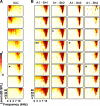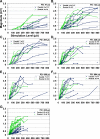Effects of pulse phase duration and location of stimulation within the inferior colliculus on auditory cortical evoked potentials in a guinea pig model
- PMID: 20717834
- PMCID: PMC2975884
- DOI: 10.1007/s10162-010-0229-0
Effects of pulse phase duration and location of stimulation within the inferior colliculus on auditory cortical evoked potentials in a guinea pig model
Abstract
The auditory midbrain implant (AMI), which consists of a single shank array designed for stimulation within the central nucleus of the inferior colliculus (ICC), has been developed for deaf patients who cannot benefit from a cochlear implant. Currently, performance levels in clinical trials for the AMI are far from those achieved by the cochlear implant and vary dramatically across patients, in part due to stimulation location effects. As an initial step towards improving the AMI, we investigated how stimulation of different regions along the isofrequency domain of the ICC as well as varying pulse phase durations and levels affected auditory cortical activity in anesthetized guinea pigs. This study was motivated by the need to determine in which region to implant the single shank array within a three-dimensional ICC structure and what stimulus parameters to use in patients. Our findings indicate that complex and unfavorable cortical activation properties are elicited by stimulation of caudal-dorsal ICC regions with the AMI array. Our results also confirm the existence of different functional regions along the isofrequency domain of the ICC (i.e., a caudal-dorsal and a rostral-ventral region), which has been traditionally unclassified. Based on our study as well as previous animal and human AMI findings, we may need to deliver more complex stimuli than currently used in the AMI patients to effectively activate the caudal ICC or ensure that the single shank AMI is only implanted into a rostral-ventral ICC region in future patients.
Figures








Similar articles
-
Auditory midbrain implant: research and development towards a second clinical trial.Hear Res. 2015 Apr;322:212-23. doi: 10.1016/j.heares.2015.01.006. Epub 2015 Jan 20. Hear Res. 2015. PMID: 25613994 Free PMC article. Review.
-
Spatially distinct functional output regions within the central nucleus of the inferior colliculus: implications for an auditory midbrain implant.J Neurosci. 2007 Aug 8;27(32):8733-43. doi: 10.1523/JNEUROSCI.5127-06.2007. J Neurosci. 2007. PMID: 17687050 Free PMC article.
-
Neural representation in the auditory midbrain of the envelope of vocalizations based on a peripheral ear model.Front Neural Circuits. 2013 Oct 21;7:166. doi: 10.3389/fncir.2013.00166. eCollection 2013. Front Neural Circuits. 2013. PMID: 24155694 Free PMC article.
-
Auditory cortical responses to electrical stimulation of the inferior colliculus: implications for an auditory midbrain implant.J Neurophysiol. 2006 Sep;96(3):975-88. doi: 10.1152/jn.01112.2005. Epub 2006 May 24. J Neurophysiol. 2006. PMID: 16723413
-
The auditory midbrain implant: a new auditory prosthesis for neural deafness-concept and device description.Otol Neurotol. 2006 Sep;27(6):838-43. doi: 10.1097/01.mao.0000232010.01116.e9. Otol Neurotol. 2006. PMID: 16936570 Review.
Cited by
-
Effects of location and timing of co-activated neurons in the auditory midbrain on cortical activity: implications for a new central auditory prosthesis.J Neural Eng. 2014 Aug;11(4):046021. doi: 10.1088/1741-2560/11/4/046021. Epub 2014 Jul 8. J Neural Eng. 2014. PMID: 25003629 Free PMC article.
-
Neural integration and enhancement from the inferior colliculus up to different layers of auditory cortex.J Neurophysiol. 2013 Aug;110(4):1009-20. doi: 10.1152/jn.00022.2013. Epub 2013 May 29. J Neurophysiol. 2013. PMID: 23719210 Free PMC article.
-
Primary auditory cortical responses to electrical stimulation of the thalamus.J Neurophysiol. 2014 Mar;111(5):1077-87. doi: 10.1152/jn.00749.2012. Epub 2013 Dec 11. J Neurophysiol. 2014. PMID: 24335216 Free PMC article.
-
Auditory midbrain implant: research and development towards a second clinical trial.Hear Res. 2015 Apr;322:212-23. doi: 10.1016/j.heares.2015.01.006. Epub 2015 Jan 20. Hear Res. 2015. PMID: 25613994 Free PMC article. Review.
-
Investigation of a new electrode array technology for a central auditory prosthesis.PLoS One. 2013 Dec 2;8(12):e82148. doi: 10.1371/journal.pone.0082148. eCollection 2013. PLoS One. 2013. PMID: 24312638 Free PMC article.
References
-
- Abeles M, Goldstein MH., Jr Functional architecture in cat primary auditory cortex: columnar organization and organization according to depth. J Neurophysiol. 1970;33:172–187. - PubMed
-
- Bierer JA, Middlebrooks JC. Auditory cortical images of cochlear-implant stimuli: dependence on electrode configuration. J Neurophysiol. 2002;87:478–492. - PubMed
-
- Blackburn CC, Sachs MB. The representations of the steady-state vowel sound /e/ in the discharge patterns of cat anteroventral cochlear nucleus neurons. J Neurophysiol. 1990;63:1191–1212. - PubMed
Publication types
MeSH terms
LinkOut - more resources
Full Text Sources
Research Materials

